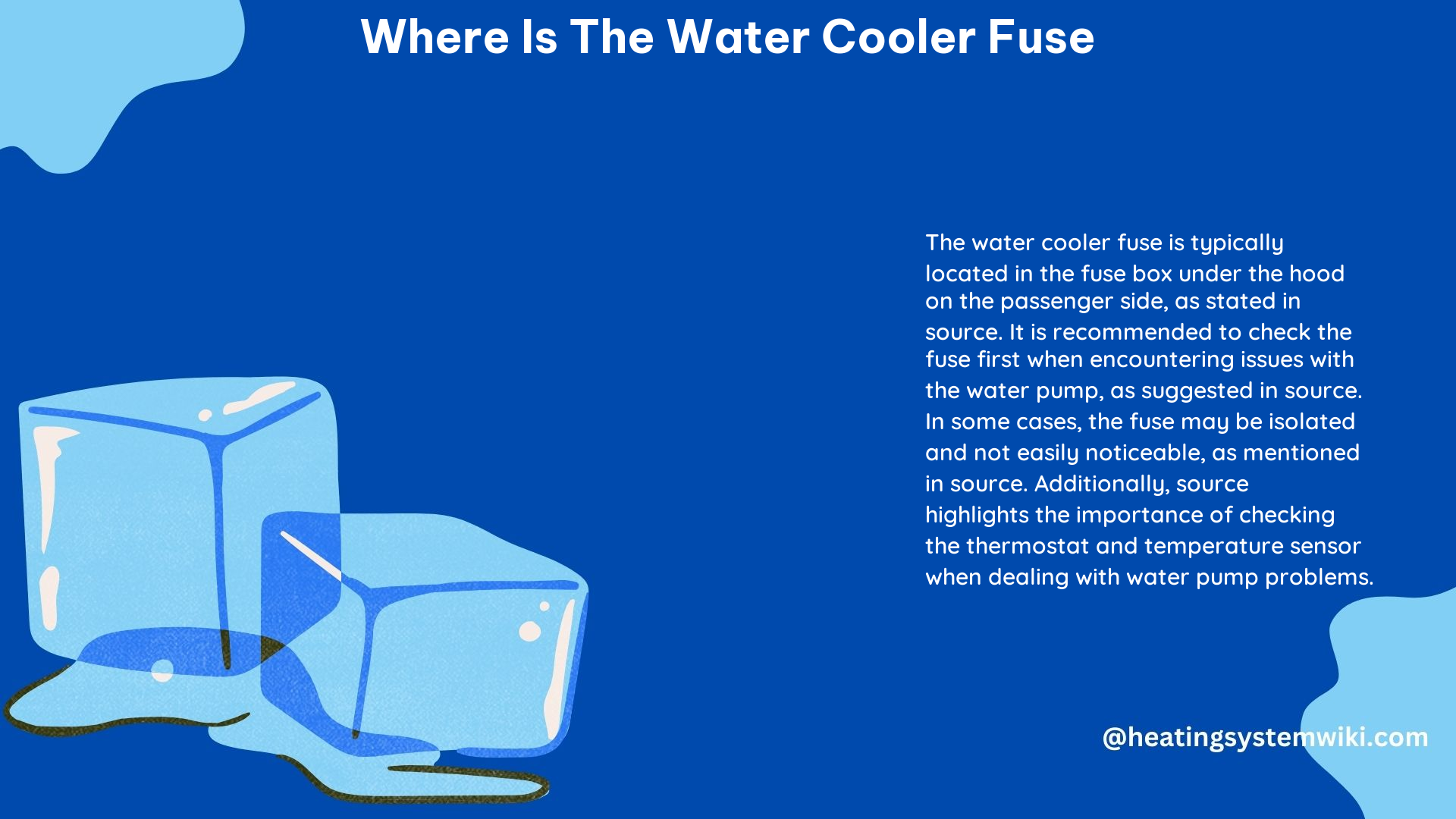The water cooler fuse is a crucial component in the electrical system of a vehicle, responsible for protecting the water pump and other related components from electrical overloads. Knowing the exact location of this fuse can be crucial when troubleshooting issues with your vehicle’s water cooling system. In this comprehensive guide, we’ll dive deep into the details of where to find the water cooler fuse, the importance of proper fuse maintenance, and the potential consequences of a blown fuse.
Locating the Water Cooler Fuse
The water cooler fuse is typically located in the fuse box or panel within the vehicle, often in the driver-side compartment up front. However, the exact location can vary depending on the make, model, and year of the vehicle.
For example, in a 2018 Open Road RV, the water pump fuse is located in channel 13 of the driver-side fuse panel and in the DC fuse panel. In some cases, the fuse box may be situated under the hood on the passenger side, requiring the removal of the fresh air filter cowl from the top of the engine to access it.
In Mercedes vehicles, the fuse for the water dispenser can be particularly challenging to locate, as it may not be immediately apparent where it is situated. In such cases, it may be necessary to consult the vehicle’s wiring diagram or seek the assistance of a professional mechanic to accurately identify the fuse location.
Fuse Identification and Replacement

When working with fuses, it’s essential to ensure that you are using the correct replacement part. Fuses come in a variety of sizes, amperage ratings, and types, and using the wrong fuse can lead to further electrical issues or even damage to the vehicle’s components.
To identify the correct fuse, you can refer to the vehicle’s owner’s manual or the fuse box diagram, which is often located on the underside of the fuse box cover or in the glove compartment. The fuse diagram will provide information on the fuse’s amperage rating, as well as its location and the component it protects.
When replacing a blown fuse, it’s crucial to turn off the power supply and unplug the device before attempting any work. This helps to prevent the risk of electrical shock or further damage to the system. Additionally, ensure that the replacement fuse is of the same amperage rating as the original to avoid overloading the circuit.
Potential Causes of a Blown Water Cooler Fuse
A blown water cooler fuse can be caused by a variety of factors, including:
- Electrical Overload: If the water pump or other related components draw more current than the fuse is rated for, the fuse will blow to protect the circuit.
- Short Circuit: A short circuit in the wiring or a malfunctioning component can cause a sudden surge of current, leading to a blown fuse.
- Corrosion: Over time, the fuse terminals can become corroded, increasing resistance and causing the fuse to blow prematurely.
- Age and Wear: Fuses can degrade and fail due to age and normal wear and tear, especially in vehicles with high mileage or those exposed to harsh environmental conditions.
Consequences of a Blown Water Cooler Fuse
A blown water cooler fuse can have serious consequences for the vehicle’s cooling system and overall performance. Without a functioning water pump, the engine can overheat, leading to potential damage to the engine block, cylinder heads, and other critical components.
In addition, a malfunctioning water cooling system can also affect the performance of other vehicle systems, such as the climate control and the engine’s ability to maintain optimal operating temperatures. This can result in reduced fuel efficiency, decreased power output, and even the activation of the vehicle’s check engine light.
Preventive Maintenance and Troubleshooting
To prevent issues with the water cooler fuse, it’s essential to regularly inspect and maintain the vehicle’s electrical system. This includes:
- Fuse Box Inspection: Regularly check the fuse box for any signs of corrosion, damage, or loose connections, and replace any blown fuses immediately.
- Wiring Inspection: Inspect the wiring harness and connections for any signs of wear, damage, or corrosion, and address any issues promptly.
- Water Pump Maintenance: Regularly inspect the water pump and related components for any signs of wear or malfunction, and replace them as needed.
- Cooling System Maintenance: Ensure that the vehicle’s cooling system is properly maintained, with regular coolant flushes and replacements as recommended by the manufacturer.
If you suspect a problem with the water cooler fuse or the vehicle’s cooling system, it’s essential to address the issue promptly. Ignoring a blown fuse or a malfunctioning water pump can lead to more severe and costly repairs down the line.
Conclusion
The water cooler fuse is a critical component in the electrical system of a vehicle, responsible for protecting the water pump and other related components from electrical overloads. By understanding the location of the water cooler fuse, the importance of proper fuse maintenance, and the potential consequences of a blown fuse, you can effectively troubleshoot and address any issues with your vehicle’s cooling system.
Remember, when working with fuses and electrical systems, it’s essential to exercise caution and follow proper safety procedures to avoid the risk of electrical shock or further damage to the vehicle. If you’re unsure about the location of the water cooler fuse or have any other concerns, it’s always best to consult a professional mechanic for assistance.
Reference:
1. Water pump fuse – iRV2 Forums
2. Trying to find the fuse that controls the water dispenser – JustAnswer
3. Water pump fuse or relay? pump not working at all – Bimmerpost
